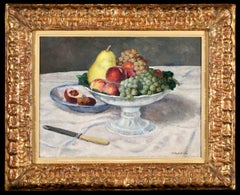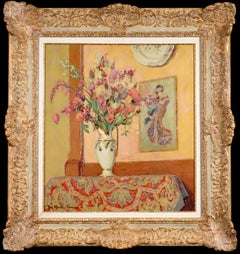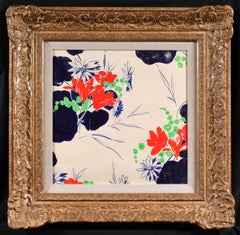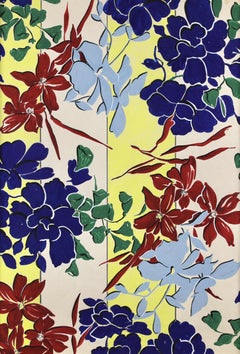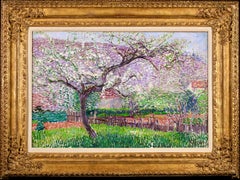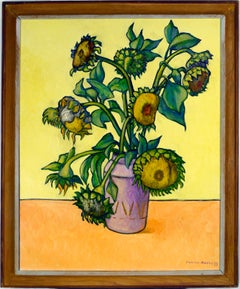Leighton Fine Art Ltd Still-life Paintings
to
7
14
6
2
Overall Width
to
Overall Height
to
3
26
5
5
8
4
1
2
1
21
8
20
8
1
6
5
2
2
2
1
1
1
1
1
1
1
1
1
1
1
1
1
1
1
29
25
15
15
6
4
4
3
3
2
29
29
Le Dessert - Post Impressionist Still Life Oil Painting by Albert Andre
By Albert Andre
Located in Marlow, Buckinghamshire
Signed and titled still life oil on canvas circa 1898 by French post impressionist painter Albert André. The work depicts a still life scene in an interior. A glass bowl filled with ...
Category
1890s Post-Impressionist Still-life Paintings
Materials
Canvas, Oil
Arrangement Japonais - Post Impressionist Still Life by Jacques Martin-Ferrieres
By Jacques Martin-Ferrières
Located in Marlow, Buckinghamshire
Signed still life oil on panel by French post impressionist painter Jacques Martin-Ferrieres. The work depicts an ornate cream ceramic vase with gold trim beside a blue vase filled w...
Category
1940s Post-Impressionist Still-life Paintings
Materials
Oil, Panel
Nature Morte - Post Impressionist Still Life Oil Painting by Georges D'Espagnat
By Georges d'Espagnat
Located in Marlow, Buckinghamshire
Signed oil on canvas still life circa 1910 by French post impressionist painter Georges D'Espagnat. The work depicts three ceramic vases of flowers on a table. There is a tale green ...
Category
1910s Post-Impressionist Still-life Paintings
Materials
Canvas, Oil
Projet de Tissus - Fauvist Flowers Watercolor & Gouache by Raoul Dufy
By Raoul Dufy
Located in Marlow, Buckinghamshire
Botanical watercolour and gouache on paper circa 1920 by French fauvist painter Raoul Dufy. The work depicts flowers in red, blue and green. This work was executed by Dufy as a fabric design.
Dimensions:
Framed: 19.5"x19.5"
Unframed: 12"x12"
Provenance:
Private collection of works by Raoul Dufy for Bianchini Ferier
Bianchini Ferrier Collection - Christie's London - July 2001
SF Fall Show
Raoul Dufy was one of a family of nine children, including five sisters and a younger brother, Jean Dufy, also destined to become a painter. Their father was an accountant in the employ of a major company in Le Havre. The Dufy family was musically gifted: his father was an organist, as was his brother Léon, and his youngest brother Gaston was an accomplished flautist who later worked as a music critic in Paris. Raoul Dufy's studies were interrupted at the age of 14, when he had to contribute to the family income. He took a job with an importer of Brazilian coffee, but still found time from 1892 to attend evening courses in drawing and composition at the local college of fine arts under Charles Marie Lhullier, former teacher of Othon Friesz and Georges Braque. He spent his free time in museums, admiring the paintings of Eugène Boudin in Le Havre and The Justice of Trajan in Rouen. A municipal scholarship enabled him to leave for Paris in 1900, where he lodged initially with Othon Friesz. He was accepted by the École des Beaux-Arts, where he studied under Léon Bonnat, whose innate conservatism prompted Dufy to remark later that it was 'good to be at the Beaux-Arts providing one knew one could leave'.
And leave he did, four years later, embarking with friends and fellow students on the rounds of the major Paris galleries - Ambroise Vollard, Durand-Ruel, Eugène Blot and Berheim-Jeune. For Dufy and his contemporaries, Impressionism represented a rejection of sterile academism in favour of the open-air canvases of Manet, the light and bright colours of the Impressionists, and, beyond them, the daringly innovative work of Gauguin and Van Gogh, Seurat, Cézanne, Toulouse-Lautrec and others. Dufy was an out-and-out individualist, however, and was not tempted to imitate any of these artists. He produced, between 1935 and 1937, Fée Electricité (Spirit of Electricity), the emblem for the French utilities company Electricité de France (EDF).
Dufy visited the USA for the first time in 1937, as a member of the Carnegie Prize jury. In 1940, the outbreak of war (and his increasingly rheumatic condition) persuaded him to settle in Nice. When he eventually returned to Paris 10 years later, his rheumatism had become so debilitating that he immediately left for Boston to follow a course of pioneering anti-cortisone treatment. He continued working, however, spending time first in Harvard and then in New York City before moving to the drier climate of Tucson, Arizona. The cortisone treatment was by and large unsuccessful, although he did recover the use of his fingers. He returned to Paris in 1951 and decided to settle in Forcalquier, where the climate was more clement. Within a short time, however, he was wheelchair-bound. He died in Forcalquier in March 1953 and was buried in Cimiez.
Between 1895 and 1898, Raoul Dufy painted watercolours of landscapes near his native Le Havre and around Honfleur and Falaise. By the turn of the century, however, he was already painting certain subjects that were to become hallmarks of his work - flag-decked Parisian cityscapes, Normandy beaches teeming with visitors, regattas and the like, including one of his better-known early works, Landing Stage at Ste-Adresse. By 1905-1906 Friesz, Braque, Matisse, Derain, Vlaminck, Van Dongen and Rouault were described collectively as Fauves (the wild beasts). What they had in common was a desire to innovate, but they felt constrained nonetheless to meet formally to set out the guiding principles of what promised to be a new 'movement'. Dufy quickly established that those principles were acceptable; moreover, he was most impressed by one particular painting by Henri Matisse ( Luxury, Calm and Voluptuousness) which, to Dufy, embodied both novelty and a sense of artistic freedom. Dufy promptly aligned himself with the Fauves. Together with Albert Marquet in particular, he spent his time travelling the Normandy coast and painting views similar...
Category
1920s Fauvist Still-life Drawings and Watercolors
Materials
Paper, Watercolor, Gouache
Projet de Fleurs - Fauvist Flowers Gouache by Raoul Dufy
By Raoul Dufy
Located in Marlow, Buckinghamshire
Botanical gouache on paper circa 1920 by French fauvist painter Raoul Dufy. The work flowers in red and blues with green foliage against a yellow and white stripped background.
Dimensions:
Framed: 25"x20"
Unframed: 18"x13"
Raoul Dufy was one of a family of nine children, including five sisters and a younger brother, Jean Dufy, also destined to become a painter. Their father was an accountant in the employ of a major company in Le Havre. The Dufy family was musically gifted: his father was an organist, as was his brother Léon, and his youngest brother Gaston was an accomplished flautist who later worked as a music critic in Paris. Raoul Dufy's studies were interrupted at the age of 14, when he had to contribute to the family income. He took a job with an importer of Brazilian coffee, but still found time from 1892 to attend evening courses in drawing and composition at the local college of fine arts under Charles Marie Lhullier, former teacher of Othon Friesz and Georges Braque. He spent his free time in museums, admiring the paintings of Eugène Boudin in Le Havre and The Justice of Trajan in Rouen. A municipal scholarship enabled him to leave for Paris in 1900, where he lodged initially with Othon Friesz. He was accepted by the École des Beaux-Arts, where he studied under Léon Bonnat, whose innate conservatism prompted Dufy to remark later that it was 'good to be at the Beaux-Arts providing one knew one could leave'.
And leave he did, four years later, embarking with friends and fellow students on the rounds of the major Paris galleries - Ambroise Vollard, Durand-Ruel, Eugène Blot and Berheim-Jeune. For Dufy and his contemporaries, Impressionism represented a rejection of sterile academism in favour of the open-air canvases of Manet, the light and bright colours of the Impressionists, and, beyond them, the daringly innovative work of Gauguin and Van Gogh, Seurat, Cézanne, Toulouse-Lautrec and others. Dufy was an out-and-out individualist, however, and was not tempted to imitate any of these artists. He produced, between 1935 and 1937, Fée Electricité (Spirit of Electricity), the emblem for the French utilities company Electricité de France (EDF).
Dufy visited the USA for the first time in 1937, as a member of the Carnegie Prize jury. In 1940, the outbreak of war (and his increasingly rheumatic condition) persuaded him to settle in Nice. When he eventually returned to Paris 10 years later, his rheumatism had become so debilitating that he immediately left for Boston to follow a course of pioneering anti-cortisone treatment. He continued working, however, spending time first in Harvard and then in New York City before moving to the drier climate of Tucson, Arizona. The cortisone treatment was by and large unsuccessful, although he did recover the use of his fingers. He returned to Paris in 1951 and decided to settle in Forcalquier, where the climate was more clement. Within a short time, however, he was wheelchair-bound. He died in Forcalquier in March 1953 and was buried in Cimiez.
Between 1895 and 1898, Raoul Dufy painted watercolours of landscapes near his native Le Havre and around Honfleur and Falaise. By the turn of the century, however, he was already painting certain subjects that were to become hallmarks of his work - flag-decked Parisian cityscapes, Normandy beaches teeming with visitors, regattas and the like, including one of his better-known early works, Landing Stage at Ste-Adresse. By 1905-1906 Friesz, Braque, Matisse, Derain, Vlaminck, Van Dongen and Rouault were described collectively as Fauves (the wild beasts). What they had in common was a desire to innovate, but they felt constrained nonetheless to meet formally to set out the guiding principles of what promised to be a new 'movement'. Dufy quickly established that those principles were acceptable; moreover, he was most impressed by one particular painting by Henri Matisse ( Luxury, Calm and Voluptuousness) which, to Dufy, embodied both novelty and a sense of artistic freedom. Dufy promptly aligned himself with the Fauves. Together with Albert Marquet in particular, he spent his time travelling the Normandy coast and painting views similar...
Category
1920s Fauvist Still-life Drawings and Watercolors
Materials
Gouache, Paper
Pommiers en Fleurs - Post Impressionist Divisionist Landscape Oil by Leon Detroy
By Leon Detroy
Located in Marlow, Buckinghamshire
Signed oil on canvas landscape circa 1920 by French post impressionist painter Leon Detroy. The piece is painted in a divisionist style and depicts blossoming apple trees in an orcha...
Category
1920s Post-Impressionist Landscape Paintings
Materials
Canvas, Oil
Vase de fleurs - Impressionist Still Life Oil Painting by Leon Detroy
By Leon Detroy
Located in Marlow, Buckinghamshire
Signed still life oil on canvas circa 1920 by French impressionist painter Leon Detroy. The work depicts a ceramic vase filled with flowers in reds, pinks and yellows and set agains...
Category
1920s Impressionist Still-life Paintings
Materials
Canvas, Oil
Roses et Fuschias - Impressionist Still Life Oil Painting by Maxime Maufra
By Maxime Maufra
Located in Marlow, Buckinghamshire
Signed oil on canvas still life painting circa 1909 by French impressionist painter Maxime Maufra. The piece depicts pink roses and fuchsias in a garden.
Signature:
Signed lower l...
Category
Early 1900s Impressionist Still-life Paintings
Materials
Canvas, Oil
Pourquoi partir? - Post Impressionist Still Life Landscape Oil by Marcel Dyf
By Marcel Dyf
Located in Marlow, Buckinghamshire
Signed oil on canvas still life in landscape circa 1980 by sought after French post impressionist painter Marcel Dyf. The work depicts a view of a harbour from beyond the open green ...
Category
1980s Post-Impressionist Landscape Paintings
Materials
Canvas, Oil
Rio de San Barnaba, Venice 1927 - Impressionist Riverscape Oil by Emma Ciardi
By Emma Ciardi
Located in Marlow, Buckinghamshire
Signed oil on panel landscape by Italian impressionist painter Emma Ciardi. The work depicts a view of the Rio de San Barnaba which runs through Venice, It...
Category
1920s Impressionist Landscape Paintings
Materials
Oil, Panel
Champs de fleurs - Post Impressionist Landscape Oil by Jacques Martin-Ferrieres
By Jacques Martin-Ferrières
Located in Marlow, Buckinghamshire
A simply beautiful oil on canvas circa 1950 by French post-impressionist painter Jacques Martin-Ferrieres. The work is of a field filled with bright flowers in all shades of red, lil...
Category
1950s Post-Impressionist Landscape Paintings
Materials
Canvas, Oil
Haystacks - Chiemsee, Bavaria - Impressionist Landscape Oil - Otto Eduard Pippel
By Otto Eduard Pippel
Located in Marlow, Buckinghamshire
Signed oil on canvas landscape circa 1930 by German impressionist painter Otto Eduard Pippel. This wonderful and good sized piece depicts a recently harvested field in Chiemsee, Bava...
Category
1930s Impressionist Landscape Paintings
Materials
Canvas, Oil
Auribeau-sur-Siagne - Post Impressionist Landscape Oil by J Martin-Ferrieres
By Jacques Martin-Ferrières
Located in Marlow, Buckinghamshire
Signed and dated oil on panel landscape by sought after French post impressionist painter Jacques Martin-Ferrieres. This beautiful piece depicts a view of Auribeau-sur-Siagne, is a c...
Category
1930s Post-Impressionist Landscape Paintings
Materials
Oil, Panel
Projet de Tissus - Fauvist Still Life Study Gouache by Raoul Dufy
By Raoul Dufy
Located in Marlow, Buckinghamshire
Botanical gouache on paper circa 1920 by French fauvist painter Raoul Dufy. The work depicts a study of apples and pears. This work was executed by Dufy as a fabric design.
Dimensio...
Category
1920s Fauvist Still-life Drawings and Watercolors
Materials
Paper, Gouache
Vue de Dordogne - Post Impressionist Landscape Oil Painting by Charles Robin
By Georges Charles Robin
Located in Marlow, Buckinghamshire
Signed oil on board riverscape circa 1950 by French Post Impressionist painter Georges Charles Robin. The work depicts a view of the Dordogne riv...
Category
1950s Post-Impressionist Landscape Paintings
Materials
Oil, Board
Arrangement de fleurs - Impressionist Still Life Painting Oil by Leon Detroy
By Leon Detroy
Located in Marlow, Buckinghamshire
Signed still life oil on canvas circa 1930 by French impressionist painter Leon Detroy. The work depicts a vase filled with roses and peonies in deep reds and pinks.
Signature:
Sign...
Category
1930s Impressionist Still-life Paintings
Materials
Canvas, Oil
Les Vagues a Agay - Fauvist Seascape Oil Painting by Louis Valtat
By Louis Valtat
Located in Marlow, Buckinghamshire
Signed fauvist oil on panel seascape circa 1900 by French painter Louis Valtat. This stunning piece depicts a view of large waves crashing against large rocks at Agay on the Cote d'A...
Category
Early 1900s Fauvist Landscape Paintings
Materials
Oil, Panel
La Roses de Bagatelle - Fauvist Landscape Oil Painting by Louis Valtat
By Louis Valtat
Located in Marlow, Buckinghamshire
Signed fauvist oil on canvas landscape circa 1910 by French painter Louis Valtat. This stunning piece depicts a view of Bagatelle Park in the north of France in summer when all of th...
Category
1910s Fauvist Landscape Paintings
Materials
Canvas, Oil
Fleurs sur une table - Post Impressionist Still Life by Jacques Martin-Ferrieres
By Jacques Martin-Ferrières
Located in Marlow, Buckinghamshire
Signed still life oil on canvas circa 1910 by French post impressionist painter Jacques Martin-Ferrieres. The work depicts a black ceramic jar with w...
Category
1910s Post-Impressionist Still-life Paintings
Materials
Canvas, Oil
Fleurs et Papillons - Fauvist Flowers Watercolor & Gouache by Raoul Dufy
By Raoul Dufy
Located in Marlow, Buckinghamshire
Botanical watercolour and gouache on paper circa 1920 by French fauvist painter Raoul Dufy. The work depicts flowers in red and butterflies in blues, yellows, black and white. This work was executed by Dufy as a fabric design.
Dimensions:
Framed: 17"x27"
Unframed: 10"x20"
Provenance:
Private collection of works by Raoul Dufy for Bianchini Ferier
Bianchini Ferrier Collection - Christie's London - July 2001
SF Fall Show
Raoul Dufy was one of a family of nine children, including five sisters and a younger brother, Jean Dufy, also destined to become a painter. Their father was an accountant in the employ of a major company in Le Havre. The Dufy family was musically gifted: his father was an organist, as was his brother Léon, and his youngest brother Gaston was an accomplished flautist who later worked as a music critic in Paris. Raoul Dufy's studies were interrupted at the age of 14, when he had to contribute to the family income. He took a job with an importer of Brazilian coffee, but still found time from 1892 to attend evening courses in drawing and composition at the local college of fine arts under Charles Marie Lhullier, former teacher of Othon Friesz and Georges Braque. He spent his free time in museums, admiring the paintings of Eugène Boudin in Le Havre and The Justice of Trajan in Rouen. A municipal scholarship enabled him to leave for Paris in 1900, where he lodged initially with Othon Friesz. He was accepted by the École des Beaux-Arts, where he studied under Léon Bonnat, whose innate conservatism prompted Dufy to remark later that it was 'good to be at the Beaux-Arts providing one knew one could leave'.
And leave he did, four years later, embarking with friends and fellow students on the rounds of the major Paris galleries - Ambroise Vollard, Durand-Ruel, Eugène Blot and Berheim-Jeune. For Dufy and his contemporaries, Impressionism represented a rejection of sterile academism in favour of the open-air canvases of Manet, the light and bright colours of the Impressionists, and, beyond them, the daringly innovative work of Gauguin and Van Gogh, Seurat, Cézanne, Toulouse-Lautrec and others. Dufy was an out-and-out individualist, however, and was not tempted to imitate any of these artists. He produced, between 1935 and 1937, Fée Electricité (Spirit of Electricity), the emblem for the French utilities company Electricité de France (EDF).
Dufy visited the USA for the first time in 1937, as a member of the Carnegie Prize jury. In 1940, the outbreak of war (and his increasingly rheumatic condition) persuaded him to settle in Nice. When he eventually returned to Paris 10 years later, his rheumatism had become so debilitating that he immediately left for Boston to follow a course of pioneering anti-cortisone treatment. He continued working, however, spending time first in Harvard and then in New York City before moving to the drier climate of Tucson, Arizona. The cortisone treatment was by and large unsuccessful, although he did recover the use of his fingers. He returned to Paris in 1951 and decided to settle in Forcalquier, where the climate was more clement. Within a short time, however, he was wheelchair-bound. He died in Forcalquier in March 1953 and was buried in Cimiez.
Between 1895 and 1898, Raoul Dufy painted watercolours of landscapes near his native Le Havre and around Honfleur and Falaise. By the turn of the century, however, he was already painting certain subjects that were to become hallmarks of his work - flag-decked Parisian cityscapes, Normandy beaches teeming with visitors, regattas and the like, including one of his better-known early works, Landing Stage at Ste-Adresse. By 1905-1906 Friesz, Braque, Matisse, Derain, Vlaminck, Van Dongen and Rouault were described collectively as Fauves (the wild beasts). What they had in common was a desire to innovate, but they felt constrained nonetheless to meet formally to set out the guiding principles of what promised to be a new 'movement'. Dufy quickly established that those principles were acceptable; moreover, he was most impressed by one particular painting by Henri Matisse ( Luxury, Calm and Voluptuousness) which, to Dufy, embodied both novelty and a sense of artistic freedom. Dufy promptly aligned himself with the Fauves. Together with Albert Marquet in particular, he spent his time travelling the Normandy coast and painting views similar...
Category
1920s Fauvist Still-life Drawings and Watercolors
Materials
Paper, Watercolor, Gouache
Nature morte aux pommes - Post Impressionist Still Life Oil -Hippolyte Petitjean
By Hippolyte Petitjean
Located in Marlow, Buckinghamshire
Signed still life oil on canvas circa 1920 by French post impressionist painter Hippolyte Petitjean. depicting a beautifully coloured view of a vast landscape. The piece depicts a green jug, a bowl of red apples, a brown two-handled jug and a vase of flowers, all placed on a wooden table. Several landscape paintings adorn the wall behind.
Signature:
Signed with cachet lower right and again verso
Dimensions:
Framed: 26"x30"
Unframed: 18"x22"
Provenance:
Galerie de l'Institut - Centenary Exhibition of Hippolyte Petitjean (1955 ) - original labels verso
Hippolyte Petitjean started his training in Mâcon and then became a student at the École des Beaux-Arts, Paris, where he worked in Cabanel's studio. By selling two Seurat paintings...
Category
1920s Post-Impressionist Still-life Paintings
Materials
Canvas, Oil
Parc Bagatelle - Fauvist Landscape Oil Painting by Louis Valtat
By Louis Valtat
Located in Marlow, Buckinghamshire
Signed fauvist landscape oil on canvas by French painter Louis Valtat. This stunning piece depicts a view of Bagatelle Park in the north of France in summer. The trees and the flower...
Category
Early 1900s Fauvist Landscape Paintings
Materials
Oil, Canvas
Les Meules - Impressionist Landscape Oil by Jean Baptiste Armand Guillaumin
By Jean Baptiste-Armand Guillaumin
Located in Marlow, Buckinghamshire
Signed landscape oil on canvas circa 1885 by French impressionist painter Jean Baptiste Armand Guillaumin. The work depicts a farmland with haystacks pilled up into the distance unde...
Category
1880s Impressionist Landscape Paintings
Materials
Canvas, Oil
Lac du Chambon - Gele - Post Impressionist Landscape Oil by Victor Charreton
By Victor Charreton
Located in Marlow, Buckinghamshire
Signed and dated oil on board landscape by French Post-Impressionist painter Victor Charreton. The piece depicts a view of Lake Chambon, near Mont-Dore - with a view of the blue moun...
Category
1910s Post-Impressionist Landscape Paintings
Materials
Oil, Board
Interieur a la fenetre ouverte - Post Impressionist Oil by Edouard Vuillard
By Edouard Vuillard
Located in Marlow, Buckinghamshire
Signed oil on board interior by French Les Nabis painter Edouard Vuillard. The work depicts a room with a large window, outside of which are bare trees. Inside the room are three chairs and a patterned rug on the floor.
Signature:
Signed lower left
Dimensions:
Framed: 20"x13"
Unframed: 13"x6"
Provenance:
Prince Antoine Bibesco (1878-1951) - Special Envoy of Romania to the United States
Piasa Encheres - Paris Lot no. 88 - 8th April 2005 - Sold EUR 118,000 hammer price
Acquired at the above by Thomas Gibson Fine Art - London
Acquired by the previous owner from Thomas Gibson Fine Art - TEFAF Maastricht November 2005
Literature:
This work is included in the catalogue rasionne of the work of Edouard Vuillard under Ref Volume II No. 172 - illustrated and described
Access to the raisonne online can be found at the Wildenstein Plattner Institute website.
The work is described as being executed in the period 1899 to 1904 by Antoine Salomon and Guy Cogeval
Édouard Vuillard attended the Lycée Condorcet in Paris, where he made friends with Maurice Denis, Lugné-Poe, and Ker-Xavier Roussel, later his brother-in-law. He studied in Maillart’s studio; for six weeks came under the tutelage of Jean-Léon Gérôme at the École des Beaux-Arts in Paris; and later under William Bouguereau and Robert at the Académie Julian, where he became closely linked with the Nabis group (from the Hebrew word for ‘prophet’). He met Marcel Proust in 1902. From 1908, he taught at the Académie Ranson. In 1937, he was elected member of the Institute.
At first, Édouard Vuillard painted small subjects, disciplined and proficient, qualities for which the prestigious École Française was famous. His earliest still-lifes (1888) are astonishing in their decisiveness and subtlety. His empathy for the object had already compelled him to soften its appearance; the object, which, by virtue of its bright or glossy presence, remained the nonego and the ‘thing represented’ for so many others. ‘Intimacy’ developed immediately between the painter and this modest environment; inhabiting it every day enabled him to celebrate its splendour, and it was to remain his favourite environment. But he was already alternating between small portraits and still-lifes, which gained recognition because of their natural qualities and dignity of tone: a rare combination in a beginner.
About 1890, influenced indirectly by Paul Gauguin, all the certainties which the self-styled Nabis painters had contented themselves with suddenly collapsed. Everything was called into question again: both the linear layout of the picture and its colour scheme; the choice of subject and its material aspect; its manufacture and its purpose. Vuillard’s paintings at that time show surprising, bold innovations and an arbitrary power, which one would expect 15 or 20 years later at the height of the Fauvist period. The preoccupation with an internal geometry set them apart from earlier studies. From then on, the paintings were based on forms, lines, and colours. Vuillard made concessions. He produced a portrait or interior with its furniture and its wallpapers, in which the family inhabiting it, evolves. Treated with flat areas of colour and solid shades of ochres, reds, blues, and saffron yellow, without modulation, they seem to prefigure certain paintings by Henri Matisse and Roger de La Fresnaye.
In 1891, Édouard Vuillard painted an Elegant Lady, a silhouette seen from the back; a long vertical shape starting from the hair decorated with brown feathers; there is a kind of pink cloak, the tight and never-ending black skirt, erect in front of a half-open, bright orange door in a green wall, from where the light of another vertical shape emerges, which is bright yellow, and is reflected in red on the parquet at the feet of the elegant lady. This painting meets his concerns about the actual moment of creating ‘harmonies corresponding to our feeling’, and by virtue of its almost geometric structure, its drawing entirely free of detail, its light effects and colour harmonies, very much prefigures aspects of the future Abstraction movement and is oddly reminiscent of the final period of Nicolas de Staël.
All too often, Édouard Vuillard is only admired in his role as the harmonist, the serene contemplator who combines an exquisite sense of nuance, rhythms, and values with the most acute observation. These singular investigations, these three-dimensional meditations including a table, a folding metal cot...
Category
1890s Post-Impressionist Interior Paintings
Materials
Oil, Board
Nature morte aux fruits - Post Impressionist Still Life Oil by Henri Lebasque
By Henri Lebasque
Located in Marlow, Buckinghamshire
Signed oil on board still life circa 1937 by French post impressionist painter Henri Lebasque. The work depicts a basket of fruit filled with apples, grapes and oranges.
Signature:
Signed lower left
Dimensions:
Framed: 33"x36"
Unframed: 26"x29"
Provenance:
This work is included in Tome 1 of Mme. Denise Bazetoux's Catalogue Raisonne of the works of Henri Lebasque - No.895.
Madame Lenoble (by 1957)
Christie's, London, 29 November 1995, lot 191
The collection of Ann & Gordon Getty (purchased at the above sale by the Gettys)
Exhibition History:
Paris, Palais Galliéra, "Célébrités et révélations de la peinture...
Category
1930s Post-Impressionist Still-life Paintings
Materials
Oil, Board
Plage a Belle Ile - Post Impressionist Landscape Oil by Georges D'Espagnat
By Georges d'Espagnat
Located in Marlow, Buckinghamshire
Signed post impressionist landscape oil on panel by popular French painter Georges D'Espagnat. The piece depicts the beach at Belle Ile, an island off the coast of Brittany in France, at sunset. An exceptional early painting by D'Espagnat which shows the precursor influence of Fauvism which was to dominate his paintings in the following few years.
Signature:
Signed lower right
Dimensions:
Framed: 23"x26"
Unframed: 15"x18"
Provenance:
Private French collection
A certificate of authenticity from Mr. Jean-Dominique Jacquemond is available upon request.
This work will be included in the catalogue raisonne of Georges D'Espagnat under preparation by Mr. Jacquemond
From the beginning of his career, it was a constant concern of Georges d'Espagnet to assert his originality. His studies at the École des Arts Décoratifs, Paris, did not last very long, for he wanted immediate independence and decided to follow courses in the private academies of Montparnasse. In about 1900, he became acquainted with Maurice Denis, Bonnard and Vuillard, and his collaboration with Denis led to a renewal of religious art in France.
In 1903, d'Espagnet was one of the founders of the Salon d'Automne, and was appointed professor in charge of studios at the École des Beaux-Arts, Paris, in 1934. He illustrated a number of books: Rémy de Gourmont's Evil Prayers ( Oraisons mauvaises) (1896), The Saints of Paradise ( Les Saintes du paradis) (1898), Simone (1907), Sistine ( Sixtine) (1922); Alphonse Daudet's The Immortal ( L'Immortel) (1930); André Gide's The Pastoral Symphony ( La Symphonie pastorale); Francis Jammes' Clearings in the Sky ( Chairières dans le ciel) (1948).
D'Espagnet belongs to the group of artists who made the Courrier Français so successful. The drawings of his which are published in it are strongly expressive and some bear comparison with the designs of the great Renaissance masters. He also contributed to L'Image. He often placed cheerful nudes in a landscape, reminding us that, though he moved away from the Fauves, he retained their freedom of colour and arabesque. He painted many portraits, including those of Albert André, André Barbier, Victor Boucher, Déodat de Séverac, Albert Marque, André Marty and Albert Roussel. He also painted mural decorations, including a wall for the Palais de la Découverte (1937), the ceiling of the Victor Hugo Room in the Palais du Luxembourg (1939), a decorative panel for the Palais de Justice, Toulouse (1941) and interior decorations for private houses. His landscapes are Impressionist in inspiration, and work for a certain sobriety, an intimacy, both in their composition - one, two or three sketched figures and large open spaces - and in the choice of colours and treatment with the special hazy brushstroke that marks his style.
D'Espagnet took part in a number of annual Parisian exhibitions, including the Salon des Indépendants, the Salon de la Société Nationale des Beaux-Arts, the Salon d'Automne (from 1903 to 1949, except in special circumstances), the Salon de la Libre Ésthétique, Brussels (1899, 1901), the Berlin Secessionists (1940). He also exhibited at the first Salon de la Société de la Gravure sur Bois. Among other exhibitions were 1912, A Century of French Art ( Centenaire de l'art français), St Petersburg; 1916, Kunstverein, Winterthur; 1918, 1926, Galerie M. Bertheim, Paris; 1930, Contemporary French Art...
Category
Early 1900s Post-Impressionist Landscape Paintings
Materials
Oil, Panel
Voyage au Venezuela 1919 - Impressionist Seascape Oil Painting by Emilio Boggio
Located in Marlow, Buckinghamshire
Signed and dated oil on canvas seascape by French impressionist painter Emilio Boggio. The piece in a view of the vast, open ocean - a rich blue sea with white ocean foam leading to ...
Category
1910s Impressionist Landscape Paintings
Materials
Oil, Canvas
Rochers par temps gris - Impressionist Seascape Oil Painting by Emilio Boggio
Located in Marlow, Buckinghamshire
A beautiful oil on panel circa 1900 by French impressionist painter Emilio Boggio. The piece depicts a coastal scene. The blue-green water crashes against the rocks on a grey day.
S...
Category
Early 1900s Impressionist Landscape Paintings
Materials
Oil, Panel
Related Items
Sunflowers, Large Scale Modernist Floral Bouquet Still-Life by Tarmo Pasto
By Tarmo Pasto
Located in Soquel, CA
Sunflowers, Large Scale Modernist Floral Bouquet Still-Life by Tarmo Pasto.
A stunning large-scale modernist oil on canvas still-life of sunflowers by Dr. Tarmo Pasto (American, 1906-1986). This modern floral bouquet still-life, painted by Pasto in 1973, harkens back to Van Gogh's world famous turn-of-the-century depiction of the same subject. Pasto uses a modern and fresh color palette of dark green, light yellow, lavender, and peach in this vibrant modern sunflower portrayal.
Signed "Tarmo Pasto" and dated "73" lower right.
Presented in a brown painted wood frame.
Image size: 38"H x 30"L.
Framed size: 44"H x 36"W x 2"D.
Dr. Tarmo Pasto was a psychiatrist and artist, who taught psychology and art through the 1970s at California State College at Sacramento since the schools inception. He also authored a book on art...
Category
1970s Post-Impressionist Still-life Paintings
Materials
Canvas, Oil
$4,750
H 44 in W 36 in D 2 in
Mid 20th Century French Signed Oil Painting Red Tulips in Interior original frm
Located in Cirencester, Gloucestershire
Red Tulips in Interior
by Marcel Chesneau (French 1902 - 1975)
signed oil on canvas, framed
framed: 26 x 19 inches
canvas: 22 x 15 inches
provenance: private collection, France
condi...
Category
Mid-20th Century Post-Impressionist Still-life Paintings
Materials
Oil, Canvas
1950's French Fauvist Signed Oil Red Roof Tops Pink Houses Scene
Located in Cirencester, Gloucestershire
The French Town
French School (Fauvist), mid 20th century
indistinctly signed lower front
oil painting on artists board, unframed
size: 15 x 18 inches
condition: very good
provenance: from a private collection in Paris
Superb mid 20th century French Fauvist...
Category
Mid-20th Century Fauvist Landscape Paintings
Materials
Oil
Waiting (floral acrylic on canvas flowers bouquet roses peonies colorful
Located in Quebec, Quebec
Waiting is a vibrant floral depicting a luxurious flower bouquet on a table.
Comes unframed and ready to hang.
Category
2010s Post-Impressionist Still-life Paintings
Materials
Canvas, Acrylic
$3,960 Sale Price
20% Off
H 59 in W 49 in D 1.5 in
Large 1950's French Signed Oil Apple Orchard Rural Field Very Thick Oil
Located in Cirencester, Gloucestershire
Artist/ School: Marie Louise Eber (French mid 20th century), signed lower front, dated 1958 verso.
Title: "La Serenite", a beautiful Post-Impressionist m...
Category
Mid-20th Century Post-Impressionist Landscape Paintings
Materials
Oil, Canvas
Botanical Studies, Watercolours on Silk on Handmade Paper, Set of Three Tulips.
By La Roche Laffitte
Located in Cotignac, FR
A set of three fine hand painted botanical watercolour studies on silk of tulips by La Roche Laffitte. The works are signed bottom right. Some are titled and numbered (see photos) Th...
Category
Late 20th Century Still-life Paintings
Materials
Watercolor, Gouache, Handmade Paper, Silk
$1,341 Sale Price
20% Off
H 21.19 in W 15.16 in D 0.04 in
Original 70's Hand Painted Textile Design Gouache Navy Blue Color on White Paper
Located in ALCOY/ALCOI, ES
Compass Rose and Flower design. Sealed on the back with the design studio name and number 397
We offer a small number of these original illustration designs by this design studio ba...
Category
1970s Modern Still-life Drawings and Watercolors
Materials
Paper, Gouache
$1,004
H 34.65 in W 18.9 in D 0.12 in
Superb French Post-Impressionist Signed Oil Still Life Fruit & Champagne
Located in Cirencester, Gloucestershire
Artist/ School: signed Guy Benard (French, contemporary)
Title: 'Nature Morte'
Medium: oil on canvas, unframed and inscribed verso
Canvas: 18 x 21.5 inch...
Category
21st Century and Contemporary Post-Impressionist Still-life Paintings
Materials
Oil
$1,629
H 18 in W 21.5 in
"Golden Roses" Original Oil on wood Panel 17th Annual Carmel Art Festival 2010
Located in Soquel, CA
"Golden Roses" Original Oil on wood Panel 17th Annual Carmel Art Festival 2010
The painting features several roses in various stages of bloom by Laurie Kersey (American 20th C), wit...
Category
2010s Post-Impressionist Still-life Paintings
Materials
Oil, Wood Panel
$1,987 Sale Price
25% Off
H 22.5 in W 18 in D 0.75 in
Bright Pink Roses In Blue Vase Post Impressionist Signed Thick Oil Impasto
By Josine Vignon
Located in Cirencester, Gloucestershire
Roses In Vase
by Josine Vignon (French 1922-2022)
signed on front
oil painting on canvas, unframed
canvas: 18 x 13 inches
Colors: Blue colors, grey, beige, brown and white
Very go...
Category
Mid-20th Century Post-Impressionist Still-life Paintings
Materials
Canvas, Oil
$1,629
H 18 in W 13 in D 1 in
Mediterranean still life Spain oil painting spanish
By Rafael Duran Benet
Located in Barcelona, Barcelona
Rafael Duran Benet (1931-2015) - Still life - Oil
Oil on canvas glued to board.
Measures work 46x55 cm.
Frameless.
Rafael Duran Benet (Terrassa, 1931 - Barcelona, 2015) is a Catalan...
Category
Early 2000s Post-Impressionist Still-life Paintings
Materials
Canvas, Oil, Board
$589 Sale Price
50% Off
H 18.12 in W 21.66 in
1940's French Floral Still Life Pink Red Roses in Brown Vase Oil Painting
Located in Cirencester, Gloucestershire
Floral Still Life
signed oil on canvas, unframed
dated 1941
Canvas : 20 x 26 inches
inscribed verso
Provenance: private collection, Paris
Condition: very good condition
Description:...
Category
Mid-20th Century Post-Impressionist Still-life Paintings
Materials
Canvas, Oil
